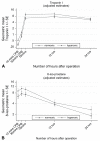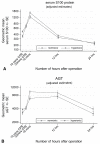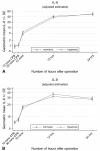The effects of normoxic versus hyperoxic cardiopulmonary bypass on oxidative stress and inflammatory response in cyanotic pediatric patients undergoing open cardiac surgery: a randomized controlled trial
- PMID: 19577081
- PMCID: PMC2840834
- DOI: 10.1016/j.jtcvs.2008.12.028
The effects of normoxic versus hyperoxic cardiopulmonary bypass on oxidative stress and inflammatory response in cyanotic pediatric patients undergoing open cardiac surgery: a randomized controlled trial
Abstract
Objectives: This study investigates the effects of controlled reoxygenation cardiopulmonary bypass on oxidative stress, inflammatory response, and organ function in children undergoing repair of cyanotic congenital heart defects.
Methods: Sixty-seven cyanotic patients (median age 15 months, interquartile range 6-49 months) undergoing corrective cardiac surgery were randomized to receive either controlled normoxic (50-0 mm Hg; n = 35) or hyperoxic (150-180 mm Hg; n = 32) cardiopulmonary bypass. Troponin I and 8-isoprostane, C3a, interleukins 6, 8, and 10, cortisol, protein S100, and alpha-glutamate transferase were measured preoperatively and 10 and 30 minutes after starting bypass, on removal of the aortic crossclamp, and 12 and 24 hours thereafter.
Results: Overall, troponin I and 8-isoprostane levels were lower in the controlled normoxic group (-29%, 95% CI -48% to -3%, P = .03, and -26%, 95% CI -44% to -2%, P = .03, respectively). Protein S100 release was also lower in the normoxic group 10 minutes after starting bypass (-26%, 95% CI -40% to -9%, P = .005) and 10 minutes after aortic crossclamp removal (-23%, 95% CI -38% to -3%, P = .02, respectively), but similar at other time points in the two groups (P >or= .17). The alpha-glutamate transferase release was significantly lower in the normoxic group 10 minutes after aortic crossclamp removal (-28%, 95% CI -44% to -9%, P = .006, respectively) but was similar at other times (P >or= .11). Release of C3a, interleukins 6, 8, and 10, and cortisol was similar in the two groups throughout (P >or= .15).
Conclusion: Controlled reoxygenation on starting cardiopulmonary bypass is associated with reduced myocardial damage, oxidative stress, and cerebral and hepatic injury compared with hyperoxic bypass and similar whole body inflammatory and stress response in cyanotic children undergoing open cardiac surgery.
Figures





References
-
- Castaneda AR, Jonas RA, Mayer JE, Hanley FL. Myocardial preservation in the immature heart. Cardiac surgery of the neonate and infant. Saunders; Philadelphia: 1994. p. 41.
-
- Hammon JW. Myocardial protection in the immature heart. Ann Thorac Surg. 1995;60:839–42. - PubMed
-
- Morita K, Ihnken K, Buckberg GD, Sherman MP, Young HH. Studies of hypoxemic/reoxygenation injury: without aortic clamping. IX. Importance of avoiding perioperative hyperoxaemia in the setting of previous cyanosis. J Thorac Cardiovasc Surg. 1995;110:1235–44. - PubMed
-
- Ihnken K, Morita K, Buckberg GD, Sherman MP, Young HH. Studies of hypoxemic/reoxygenation injury: without aortic clamping. III. Comparison of the magnitude of damage by hypoxemia/reoxygenation versus ischemia/reperfusion. J Thorac Cardiovasc Surg. 1995;110:1182–9. - PubMed
-
- Imura H, Caputo M, Parry A, Pawade A, Angelini GD, Suleiman MS. Age-dependent and hypoxia-related differences in myocardial protection during pediatric open heart surgery. Circulation. 2001;103:1551–6. - PubMed

